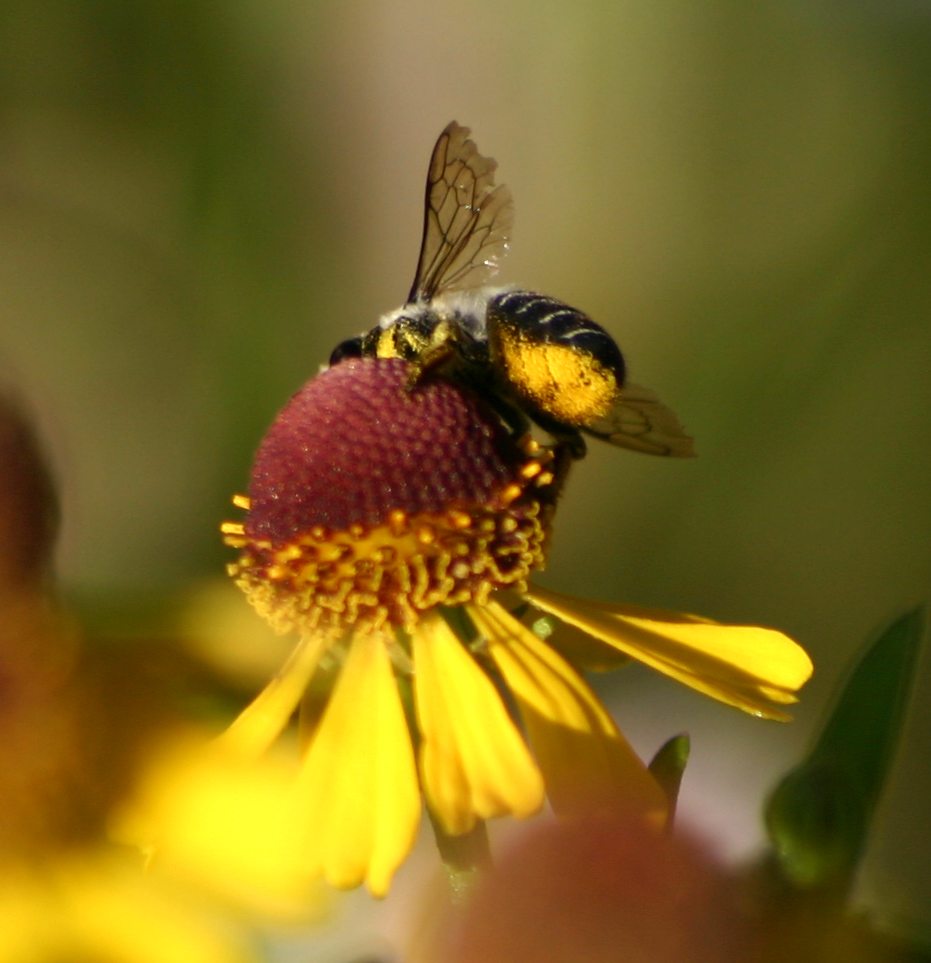Scopa (biology) on:
[Wikipedia]
[Google]
[Amazon]
 A scopa (plural scopae; Latin for "broom") is any of a number of different modifications on the body of a non-parasitic
A scopa (plural scopae; Latin for "broom") is any of a number of different modifications on the body of a non-parasitic 

 A scopa (plural scopae; Latin for "broom") is any of a number of different modifications on the body of a non-parasitic
A scopa (plural scopae; Latin for "broom") is any of a number of different modifications on the body of a non-parasitic bee
Bees are winged insects closely related to wasps and ants, known for their roles in pollination and, in the case of the best-known bee species, the western honey bee, for producing honey. Bees are a monophyletic lineage within the superfami ...
that form a pollen
Pollen is a powdery substance produced by seed plants. It consists of pollen grains (highly reduced microgametophytes), which produce male gametes (sperm cells). Pollen grains have a hard coat made of sporopollenin that protects the gametop ...
-carrying apparatus. In most species of bees, the scopa is simply a dense mass of elongated, often branched, hairs (or setae
In biology, setae (singular seta ; from the Latin word for "bristle") are any of a number of different bristle- or hair-like structures on living organisms.
Animal setae
Protostomes
Annelid setae are stiff bristles present on the body. ...
) on the hind leg. When present on the hind legs, the modified hairs are, at a minimum, on the tibia
The tibia (; ), also known as the shinbone or shankbone, is the larger, stronger, and anterior (frontal) of the two bones in the leg below the knee in vertebrates (the other being the fibula, behind and to the outside of the tibia); it conn ...
, but some bees also have modified hairs on the femur
The femur (; ), or thigh bone, is the proximal bone of the hindlimb in tetrapod vertebrates. The head of the femur articulates with the acetabulum in the pelvic bone forming the hip joint, while the distal part of the femur articulates ...
and/or trochanter
A trochanter is a tubercle of the femur near its joint with the hip bone. In humans and most mammals, the trochanters serve as important muscle attachment sites. Humans are known to have three trochanters, though the anatomic "normal" includes ...
. A few bees have, in addition to the leg hairs, many modified hairs on the ventral surface of the abdomen which are also used in pollen transport; one family of bees, the Megachilidae
Megachilidae is a cosmopolitan family of mostly solitary bees. Both that their pollen-carrying structure (called a '' scopa'') is restricted to the ventral surface of the abdomen (rather than mostly or exclusively on the hind legs as in other ...
, lack modified leg hairs, but have an extensive scopa on the underside of the abdomen (see photo).
Honey bee
A honey bee (also spelled honeybee) is a eusocial flying insect within the genus ''Apis'' of the bee clade, all native to Afro-Eurasia. After bees spread naturally throughout Africa and Eurasia, humans became responsible for the current cosm ...
s and bumblebee
A bumblebee (or bumble bee, bumble-bee, or humble-bee) is any of over 250 species in the genus ''Bombus'', part of Apidae, one of the bee families. This genus is the only Extant taxon, extant group in the tribe Bombini, though a few extinct r ...
s have a more highly-developed structure than the scopa: the corbicula
''Corbicula'' is a genus of freshwater and brackish water clams, aquatic bivalve mollusks in the family Cyrenidae, the basket clams.Gofas, S. (2015). Cyrenidae Gray, 1847. In: MolluscaBase (2015). Accessed through: World Register of Marine Sp ...
, or pollen basket
The pollen basket or corbicula (plural corbiculae) is part of the tibia on the hind legs of certain species of bees. They use the structure in harvesting pollen and carrying it to the nest or hive. Other species of bees have scopae instead.
Ety ...
. Various species of bees have other types of modified hairs that collect pollen, floral oils, or other chemicals from plants; such hairs may be borne on the face, mouthparts, or the front or middle legs, but such hairs are not called scopae. The term "scopa" is restricted to hairs adapted to the transport of pollen.
Some species of bees transport pollen internally in the crop
A crop is a plant that can be grown and harvested extensively for profit or subsistence. When the plants of the same kind are cultivated at one place on a large scale, it is called a crop. Most crops are cultivated in agriculture or hydropon ...
, and they lack a scopa, as do kleptoparasitic
Kleptoparasitism (etymologically, parasitism by theft) is a form of feeding in which one animal deliberately takes food from another. The strategy is evolutionarily stable when stealing is less costly than direct feeding, which can mean when f ...
bees, which do not gather their own pollen.Proctor, M.; Yeo, P.; Lack, A. (1996). ''The Natural History of Pollination''. Timber Press, Portland, Oregon


See also
*Corbicula
''Corbicula'' is a genus of freshwater and brackish water clams, aquatic bivalve mollusks in the family Cyrenidae, the basket clams.Gofas, S. (2015). Cyrenidae Gray, 1847. In: MolluscaBase (2015). Accessed through: World Register of Marine Sp ...
References
{{DEFAULTSORT:Scopa (Biology) Pollination Bees Arthropod anatomy